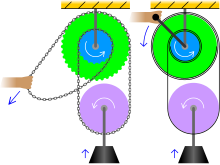Windlass


The windlass /ˈwɪndləs/ is an apparatus for moving heavy weights. Typically, a windlass consists of a horizontal cylinder (barrel), which is rotated by the turn of a crank or belt. A winch is affixed to one or both ends, and a cable or rope is wound around the winch, pulling a weight attached to the opposite end. The Greek scientist Archimedes was the inventor of the windlass.[1] The oldest depiction of a windlass for raising water can be found in the Book of Agriculture published in 1313 by the Chinese official Wang Zhen of the Yuan Dynasty (fl. 1290–1333).[2]
Uses
- Vitruvius, a military engineer writing about 28 BC, defined a machine as "a combination of timber fastened together, chiefly efficacious in moving great weights." About a century later, Hero of Alexandria summarized the practice of his day by naming the "five simple machines" for "moving a given weight by a given force" as the lever, windlass, screw for power, wedge, and tackle block (pulley). Until nearly the end of the nineteenth century it was held that these "five mechanical powers" were the building blocks from which all more complex assemblages were constructed.' [3]
- During the Middle Ages the windlass was used to raise materials for the construction of buildings such as in Chesterfield's crooked spire church.[4]
- A windlass cocking mechanism on crossbows was used as early as 1215 in England, and most European crossbows had one by the Late Middle Ages.[5]
- Windlasses are sometimes used on boats to raise the anchor as an alternative to a vertical capstan (see anchor windlass).
- The handle used to open locks on the UK's inland waterwaysis called a windlass.
- Windlass can be used to raise water from a well windlass, a rotating wooden rod installed across the mouth of a well, is found in Isidore of Seville's (c. 560–636) Origenes (XX, 15, 1–3).[6]
- Windlass have also been used in gold mining. A windlass would be constructed above a shaft which allowed heavy buckets to be hauled up to the surface.[7] This process would be used until the shaft got below 40 metres deep when the windlass would be replaced by a 'whip' or a 'whim'.[8]
Differential windlass

In a differential windlass, also called a Chinese windlass,
Spanish windlass

A Spanish windlass is a device for tightening a rope or cable by twisting it using a stick as a lever. The rope or cable is looped around two points so that it is fixed at either end. The stick is inserted into the loop and twisted, tightening the rope and pulling the two points toward each other. It is commonly used to move a heavy object such as a pipe or a post a short distance. It can be an effective device for pulling cars or cattle out of mud.[12] A Spanish windlass is sometimes used to tighten a tourniquet or a straitjacket. A Spanish windlass trap can be used to kill small game. An 1898 report to the US Senate Committee on Foreign Relations about an American vessel captured by a Spanish gunboat described the Spanish windlass as a torture device.[13] One of the captives' wrists were tied together. The captor then twisted a stick in the rope until it tightened and caused the man's wrists to swell.
See also
References
- ^ Sarton, George (1959). A History of Science. Vol. 2. Harvard University Press, Cambridge. p. 123.
{{cite book}}:|work=ignored (help) - ^ Needham, Joseph (1986). Science and Civilisation in China. Vol. 4, Physics and Physical Technology. Taipei: Caves Books, Ltd.
{{cite book}}:|work=ignored (help) - ^ Hartenberg, Richard; Danavit, Jacques (1964). "Kinematic Synthesis of linkages". McGraw-Hill.
- ^ "Medieval Builders' Windlass". BBC. Retrieved September 11, 2012.
- ^ "Engineering the Medieval Achievement-The Crossbow". MIT. Retrieved September 11, 2012.
- ISBN 90-277-1693-5
- ^ "Albert Goldfields Mining Heritage" (PDF). Outback NSW. Retrieved September 11, 2012.
- ^ "Searching for Gold". Kidcyber. Retrieved September 11, 2012.
- ^ "Chinese". Oxford English Dictionary (Online ed.). Oxford University Press. (Subscription or participating institution membership required.) (registration required)
- ISBN 978-0-12-200400-1
- Cassell, Petter, Galpin & Co"Chinese-windlass, a differential windlass in which the cord winds off one part of the barrel and on to the other."
- ISBN 9780803218260.
- ^ Davis, Cushman K. (1897). Report of the US Senate Committee on Foreign Relations.
